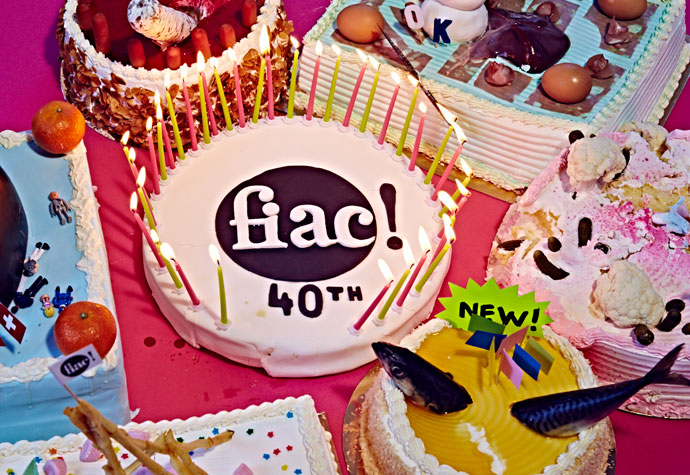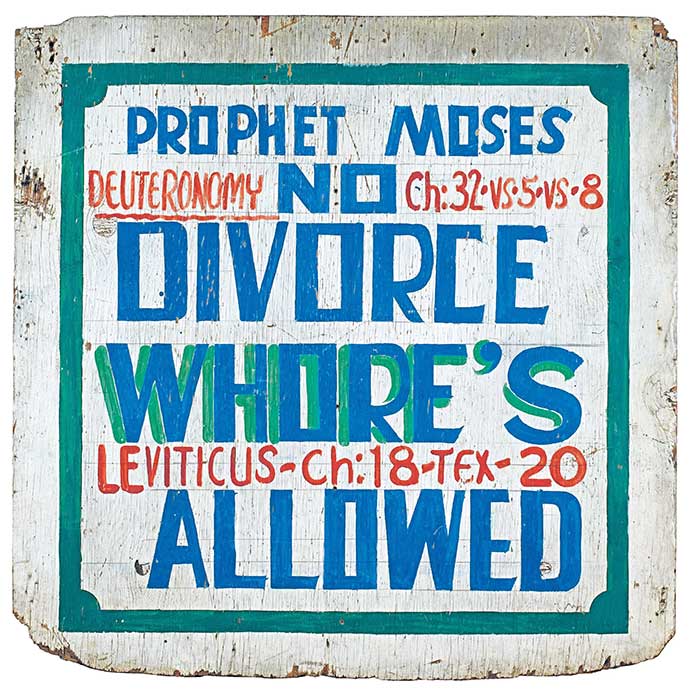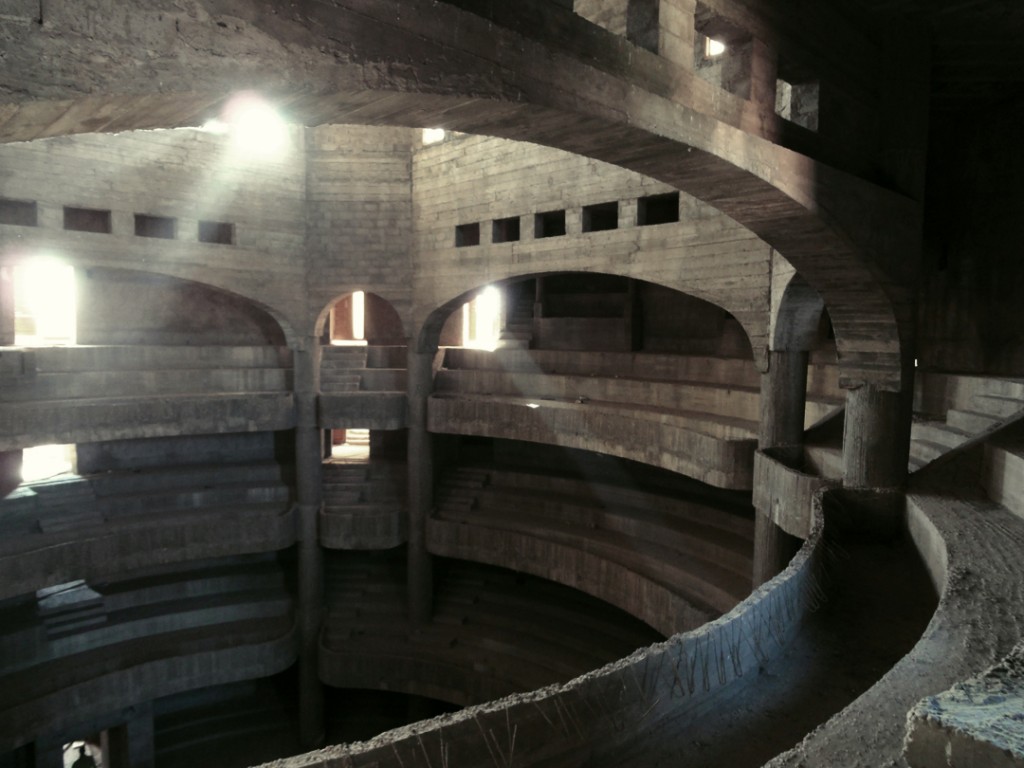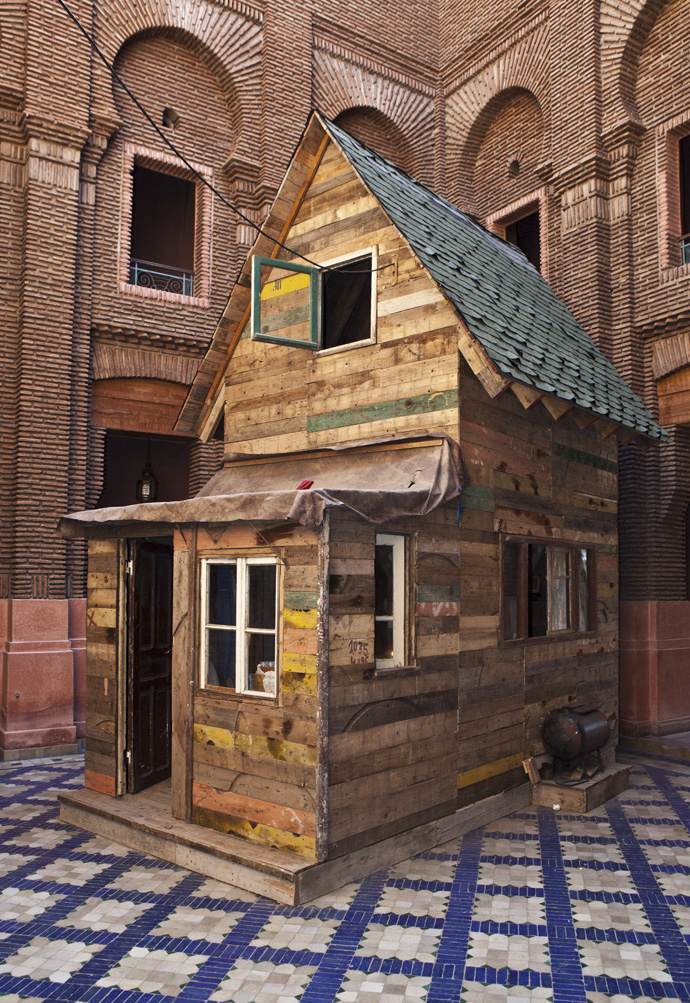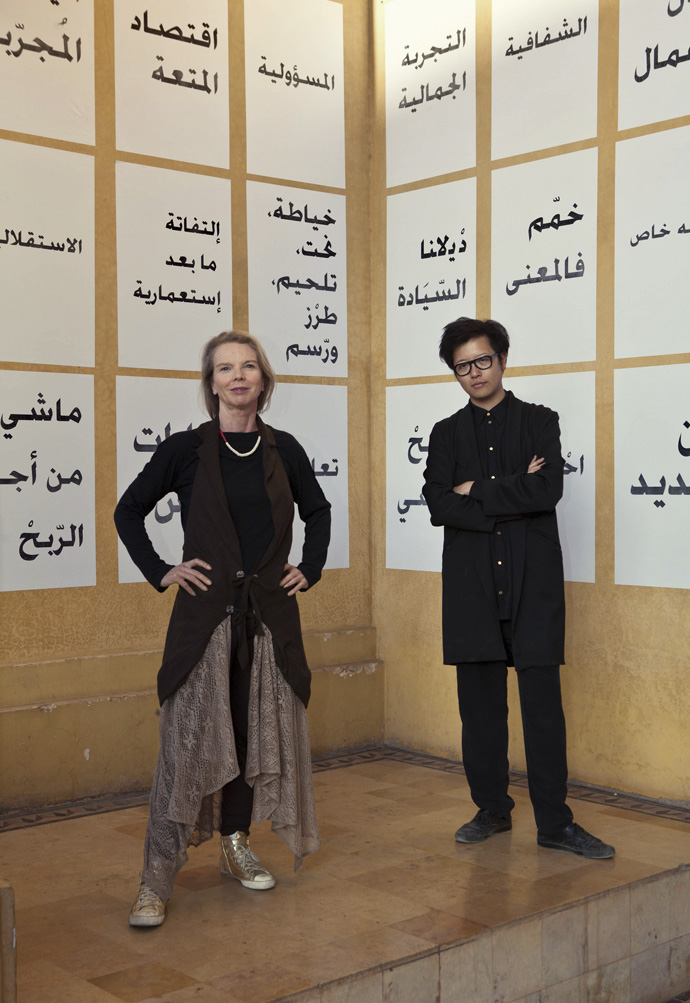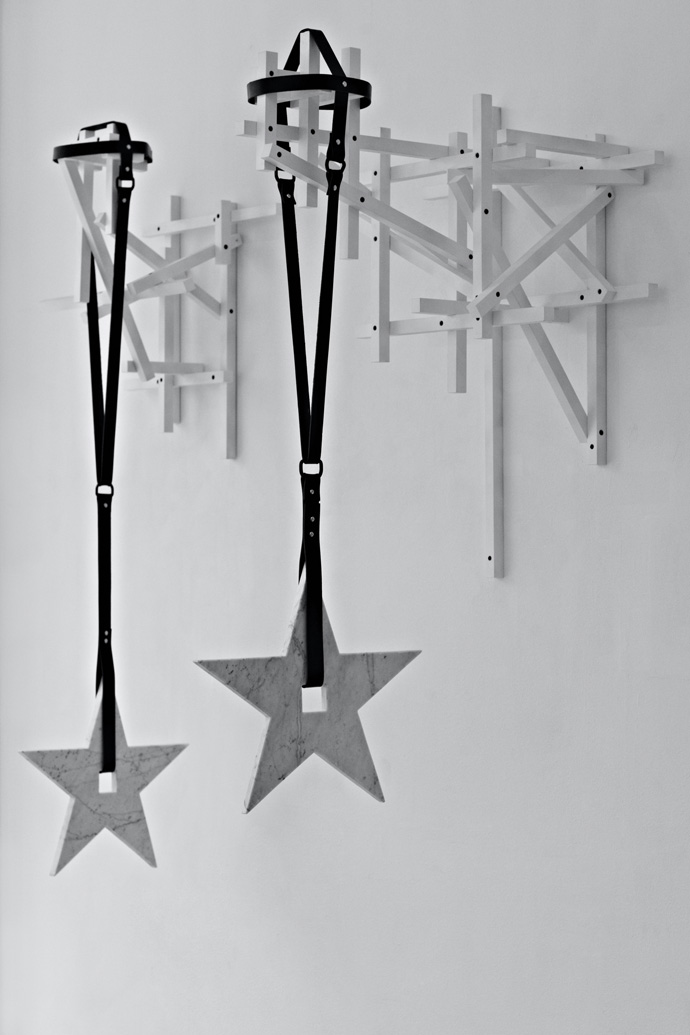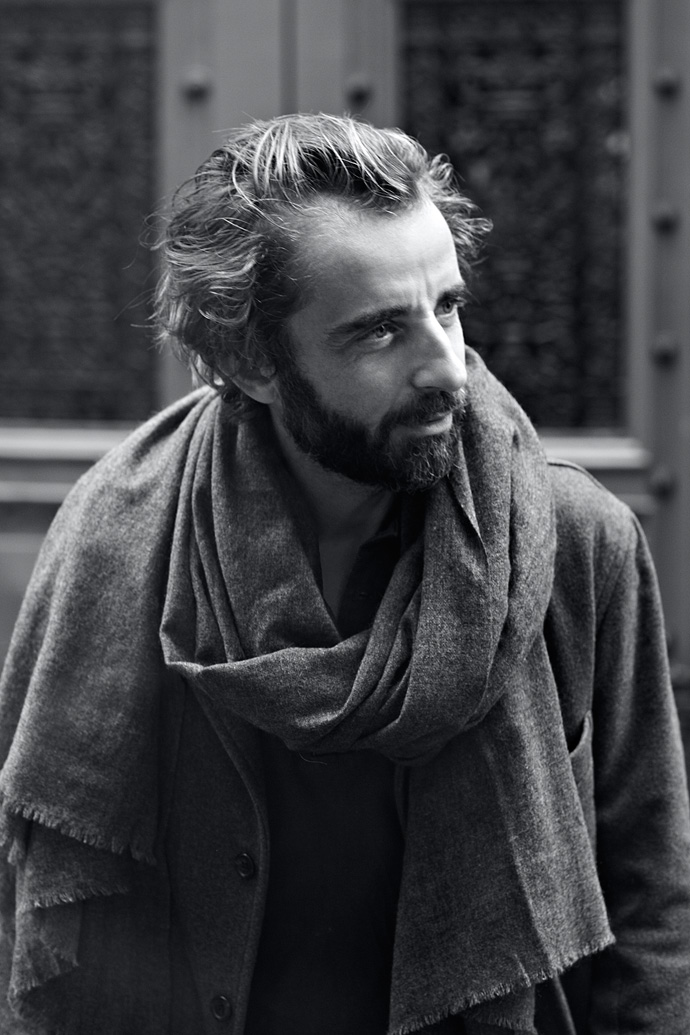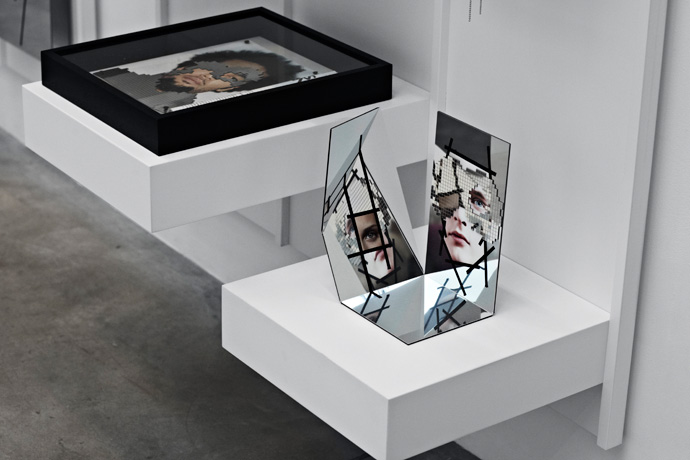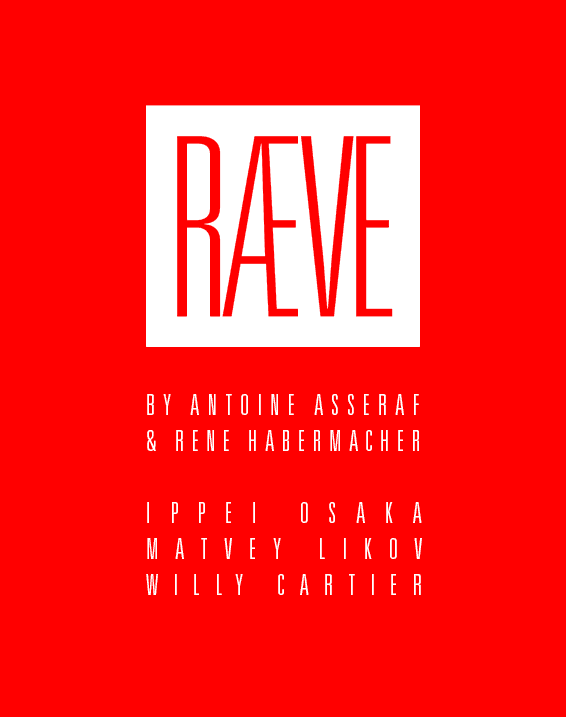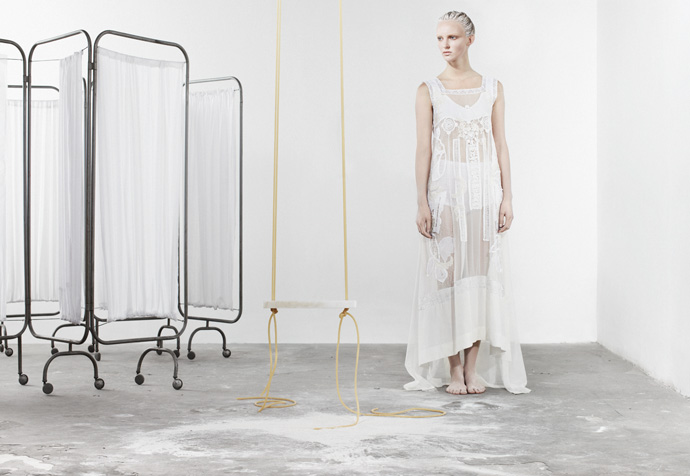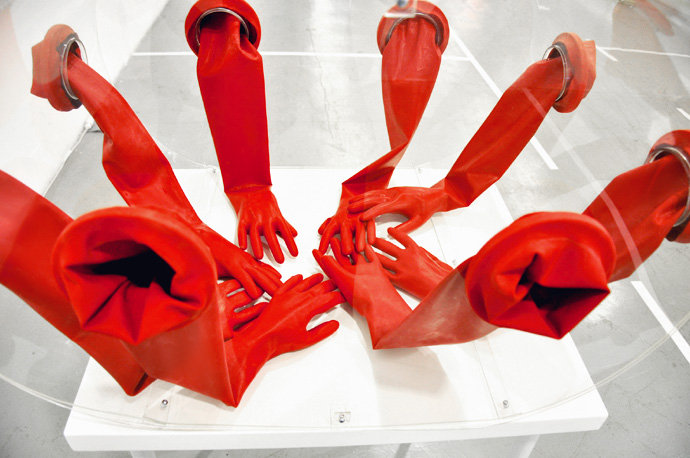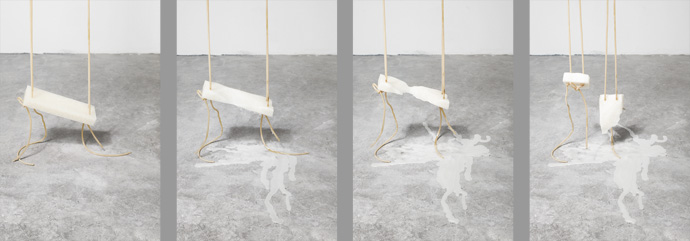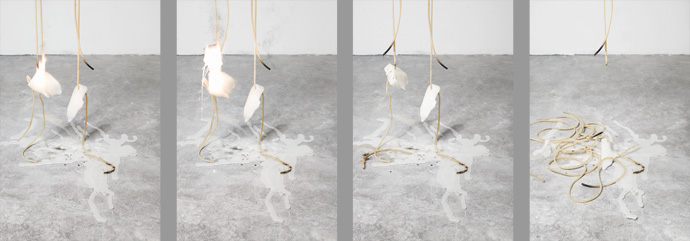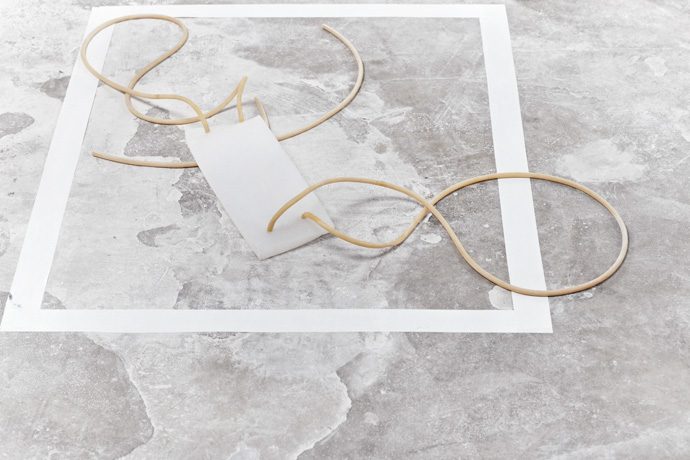-

what the FIAC ?!
-OK people, fashion time’s over. It’s Art time.
Appetite for contemporary art is always growing. The public, the collectors…everyone wants a piece of the cake.
So The Stimuleye is proud to present, for the second year in a row in association with SayWho, the official film of the 40th Paris Contemporary Art Fair a.k.a. FIAC 2013.
WhatTheFIAC, written & directed by Antoine Asseraf.
FIAC, Foire Internationale d'Art Contemporain, 2013 trailer, directed by Antoine Asseraf.
For its 40th edition, and in order to accommodate the ever-growing interest in the art scene, the FIAC is expanding and taking different forms throughout Paris.
Beyond the glass dome of the Grand Palais and the hundreds of galleries showing there, the FIAC is installing artwork accessible for free to the public in its “Hors-les-murs” (‘outside the walls’) program. Prestigious locations such as the Jardin des Tuileries, Place Vendôme, and Jardin des Plantes are joined this year by the brand new Berges de Seine left bank pedestrian embankments, running from Musée d’Orsay to Quai Branly.
YUM.
FIAC 2013. Photo by René Habermacher.
FIAC 2013
October 24-27
Grand Palais
& Hors-les-Murs: Petit Palais / Berges de Seine / Jardin des Tuileries / Auditorium du Louvre / Place Vendôme / Jardin des TuileriesWhatTheFIAC
produced by SayWho
creative direction The Stimuleye
directed by Antoine Asseraf
photography by René Habermacher
art direction by Mathilde Nivet
hands by Aurélie Nguyen
voice by Lynsey Peisinger00 -

the museum of everything
-Art. What is it ? Where does it start, and where does it end ?
In today’s contemporary art “market”, it seems no one bothers asking the question anymore.
Art, as it would appear, is whatever is made by a self-claimed artist, whatever is recognized by the market.Enter The Museum of Everything.
Premiering in Paris at the new Saint-Germain location Chalet Society after several exhibits in London, this groundbreaking, sprawling, multi-level and multi-layered show changes the game.Forget the market.
For founder James Brett, it’s about special things, made by special people, people who haven’t gone to art school or thought of showing their work, much less of selling it.Antoine Asseraf: What started you on The Museum of Everything project ?
James Brett: I don’t come from a particularly artistic family and my parents never taught me what creativity meant – but as a child I had a lot of it and it always got in the way.And so I worked in different industries and was working in film, and I remember meeting a very interesting photographer, the late Bob Richardson. He was the father of Terry Richardson. Terry’s a terrible photographer (sorry!) but Bob was a genius. He was the first person who really told me that “You don’t choose it, it chooses you”.
In the same way, I can’t really tell you why I started The Museum of Everything. I didn’t set out to do it, I wasn’t interested in art, exhibitions, nothing. But I was working in film and I know film very well, I studied acting, so I’m creatively interested. And in my travels I started to see artworks, first of all by people in the American South, that was just cool and graphic. I always liked graphic novel and comics as a child – and as an adult frankly – and they started speaking to me.
The artworks were cheap, really like 20-25 bucks, and the more I looked the more I found. I started finding better examples, and realized there was a whole history in America of folk art, African-American art and self-taught art which seemed to come from the individual, it didn’t have the pretension or the words of formally-trained artists, and it was immediate. As a film-maker I loved that, because I’m not really interested in what you are or what you say, I’m interested in the stuff, in what you do.
As I continued I saw there were some other areas that had a great psychological depth. For example, the work of Henry Darger. I discovered there was a word for it, Art Brut, of which Dubuffet was the proponent. And that also interested me because in my youth, I was fascinated by the mind, how the mind works, and why we make the choices we do, all of this sort of existential philosophy of life.
Prophet Royal Robertson untitled (NO DIVORCE WHORE's ALLOWED), c 1980 © The Museum of Everything
-

FIAC 2012 art fair
-The time to FIAC is now. The Stimuleye presents 2 films in partnership with Saywho:
A portrait of sculptor Jaume Plensa, whose statues are installed place Vendôme.
The opening day of the FIAC fair, with interview of director Jennifer Flay, artists Xavier Veilhan and Matthieu Laurette, and featuring Michele Lamy, Emmanuel Perrotin and many others
FIAC 2012 OPENING VERNISSAGE BY SAYWHO from SAYWHO on Vimeo.
Jaume Plensa from SAYWHO on Vimeo.
-

HIGHER ATLAS – Marrakech Biennale
-The Arab Spring.One year later, the events seem so distant already, and yet an undeniable change has taken place in the atmosphere.
A special case: Marocco, where evolution, rather than revolution, is being encouraged through a revised constitution. And now, the Marrakech Biennale, HIGHER ATLAS, curated by Carson Chan and Nadim Samman under the patronage of Vanessa Bronson, opens its door.
A special case, a special place, in a special time… an interview with curator Carson Chan.
The Théatre Royal, under construction.
How was lunch?
Thanks for asking! There’s been little time for lunch these days, but the 6 dirham omelets across from one of exhibition sites, the Théâtre Royal, are great.Now that you spend so much time in Marrakech- what are your favorite places you hang out to get a fresh head?With my indispensable curatorial assistant, Marie Egger, we often duck away for an hour at the Cafe de la Poste, a beautiful colonial-era restaurant.
Did you accustom to the local rhythm?It took a few weeks, but I think I finally got a hang of how to deal with contractors, suppliers, interns, accountants and bureaucracy in Marrakech. This time around, I’ve been here for more than a month, and it’s been great to become familiar with some of the people in my neighbourhood. That being said, I’m still often my own tourist attraction!
So did you surrender? Or is it the other way around?I think everyone involved has surrendered to the biennial making process. I knew that logistics would be a challenge, but in the end, the exhibition, often spectacular, sometimes very quiet, was curated to appeal first and foremost to the senses.
How did your engagement with the Marrakech biennale and Nadim Samman come together?We were invited December 2010. I ended up meeting Vanessa Branson, the president of the Arts in Marrakech foundation at Art Basel Miami, and was hired after a brief presentation of my past exhibitions on my ipad! She had met Nadim a month earlier in London at an exhibition he made there.
You had initially planned the El Badi palace to be at the core of the Higher Atlas biennale. As I understand one of the challenges you faced with the change of administration was that at some point El Badi was no longer available. What were the consequences?The consequences of losing the El Badi palace was pretty great in the end! The show now spans five different sites in and around Marrakech, so when traveling from one location to another, visitors, both local and from abroad, will begin to see the city as part of the context of the exhibition.
The Théâtre Royal, a half completed opera house commissioned by King Hassan II, the old foundations and underground cisterns of the sacred Koutoubia Mosque, the so-called Cyber Park (it’s owned by Moroc Telecom and has perhaps the best wifi in the city!), the Bank al-Maghrib building in the historic Djemaa el-Fna square as well as an large scale sculptural installation by Elin Hansdottir in the town of Tassoultante about 15km outside of the city are all places where we have exhibitions.
Particularly in the urban public spaces like the square, the park and Koutoubia, it has been amazing to see visitors that have had very little exposure to contemporary art stay and take time to experience the work.
Installation by Ethan Hayes-Chute.
Did the “arab spring” affect you curating this project?The so-called Arab Spring (no one here would ever associate any kind of political unrest as a problem relating to other countries…) was definitely on my mind when I started conceptualizing the exhibition. Before spending time at in Marrakech, all I knew of Morocco was what I read about in the media – a politics biased reading if anything. The very fact that we made an exhibition of contemporary culture was a response to politic-heavy understanding of North Africa.
People here go shopping, go to restaurants, read books, watch movies and use the internet for YouTube just like everywhere else.
One of the biennales goals are articulating the blurred boundaries between historically discrete spheres, and the conjunction of local and global conditions. Which works would you allocate to this specific target, and how do you see their relevance?I would say Jon Nash’s work, Moroccan Drift, is a good example. When he was researching Morocco online, he came across several drift videos in which people would speed up their cars and turn in such a way that the car moves sideways. Inspired by Tokyo drift and other videos from around the world, young Moroccans made their own Moroccan drift videos.
In the end, it was the space opened up by the Internet, not, say, geo-politics, that shaped the cultural lives of the Moroccans making these videos. Morocco is used by filmmakers as stand-ins for several other places. Ridley Scott shot Prince of Persia here, and of course Morocco is no where near Persia. Large HDI balloons are often used as stand ins for the moon, and American artist, Karthik Pandian, decided to launch one of them in the Djemaa el-Fna square for one night. On that night, March 2nd, Marrakech had two moons, the real one, and the one Karthik launched, which was cubic in shape – a gigantic white cube, as it were.
Was it difficult for you to get rid of the post-colonial shades and orientalist romanticism?Post-colonialism and its echos are definitely here, but not unlike other cities like Hong Kong, Montreal or Mexico City. We worked with about 50 university students from the Cadi Ayyad University, and they definitely regard themselves as either Moroccan or simply world citizens, not products of post-colonialism. In fact, I consciously tried to bypass this framework by foregrounding art as a question of physical experience, rather than a communicator of historical conditions. Having said that, Leung Chi Wo, from Hong Kong, reflected on post-colonial identities in his work.
Right, Carson Chan, co-curator, and left, Vanessa Bronson, biennale founder.
I am curious to hear a little on the locals reactions in this context?The local reaction so far has been amazing! If anything, it has really gotten people talking. Thousands came to our opening, and we are being featured in the local media – radio, television, newspaper, magazines – on a daily basis. Our interns, who have worked for the past two months alongside myself and our artists, are our main ambassadors. They tell people on the street, friends, make their own ads and posters about the show.
I went to check up on the Koutoubia exhibition the other days and it was packed with people streaming in from the main square. At the Bank al-Maghrib, where Nine Eglantine Yamamoto-Masson curated video art as part of a walk-in screening room, I saw families sitting inside entranced by the videos.
How did you encounter the local support when approaching it?Not only do we have support from the mayor, the Wali of Marrakech and just recently the patronage of the King himself, the love and support we get from our contractors and workers has been immense. One contractor, Said Aakif, has been instrumental to the success of the biennale, and we’re all really grateful for his dedication.You recently halted your project PROGRAM in Berlin, what was the decision? And, in retrospect how do you see this curatorial experience has affected you?
Fotini Lazaridou-Hatzigoga and I ran PROGRAM for more than 5 years, and as a project that experimented in art and architecture exhibitions, we felt that we had had our run.There will definitely be more projects through PROGRAM, but the experience there has definitely shaped my work here in Marrakech. To start with, many of the artists I’ve shown there were also in the biennale.What are your plans after the Marrakech Biennale?I’m editing two magazines – editor at large for 032c, and contributing editor for Kaleidoscope – so that will take up much time. There are a few more exhibitions this year, talks and lectures, but I’m taking time to work on a conference at Yale University with David Tasman and Eeva Liisa Pelkonen about architecture exhibitions. There are a few books up my sleeve as well…
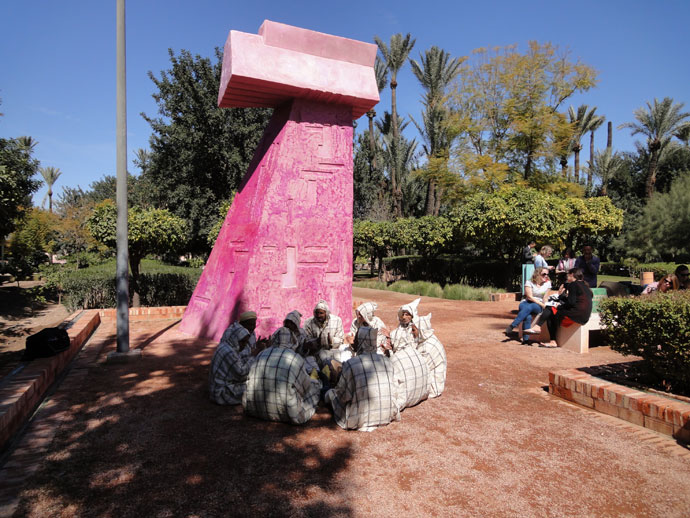 Aleksandra Domanovic's "Monument to Revolution" and the al-Ghiwane singers,
performing turner-prize nominee Roger Hiorn's untitled performance.
Aleksandra Domanovic's "Monument to Revolution" and the al-Ghiwane singers,
performing turner-prize nominee Roger Hiorn's untitled performance.
What is the last thing that stimulated you?
The most stimulating thing was the exhibition vernissage. To see people experiencing the artworks I spent so much time thinking about and considering, to see them take it in and take their time, to see people encounter things they may never have encountered before, that has been the most stimulating. -

marc turlan: STAR NOTORIOUS
-First, he covered them up with a resin mask, then he cut their eyes out, with a scalpel and after with a laser. This is not Dexter, this is artist Marc Turlan, who always finds new ways of torturing magazines.With his latest solo show EXO STAR he is taking an artistic leap, opening this saturday at Galerie Anne de Villepoix in Paris.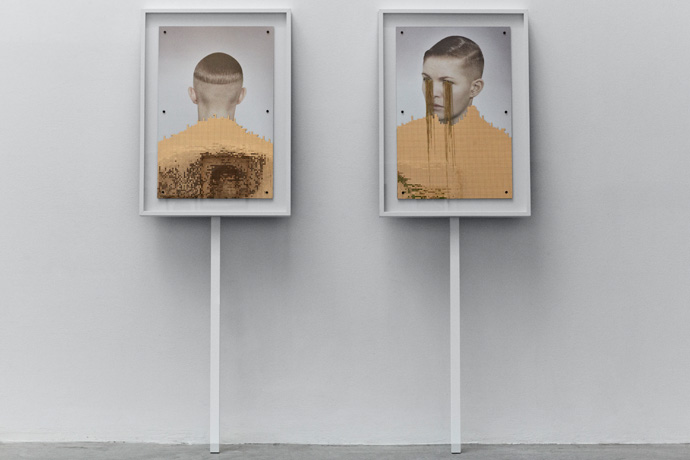 Marc Turlan: protest board 1 and 2, a collaboration with british photographer Timur Celikdag.
Courtesy gal Anne de VillepoixThe new sculptures of Marc Turlan conclude a logical extension of his appropriative work with the pages of glossy magazines:“The base of all i do is collage. The technique for my sculpture is the same way, it’s like 3 dimensional collages.”Right in the first room, the program for the exhibit gets clear: a gym workbench, weight bars in a stack, and 6 sheets of mirror, each with a word inscription of mirror mosaic, that serve as the commandments for this show: WORK – NOTORIETY – SINCERITY – POWER – LOVE
Marc Turlan: protest board 1 and 2, a collaboration with british photographer Timur Celikdag.
Courtesy gal Anne de VillepoixThe new sculptures of Marc Turlan conclude a logical extension of his appropriative work with the pages of glossy magazines:“The base of all i do is collage. The technique for my sculpture is the same way, it’s like 3 dimensional collages.”Right in the first room, the program for the exhibit gets clear: a gym workbench, weight bars in a stack, and 6 sheets of mirror, each with a word inscription of mirror mosaic, that serve as the commandments for this show: WORK – NOTORIETY – SINCERITY – POWER – LOVE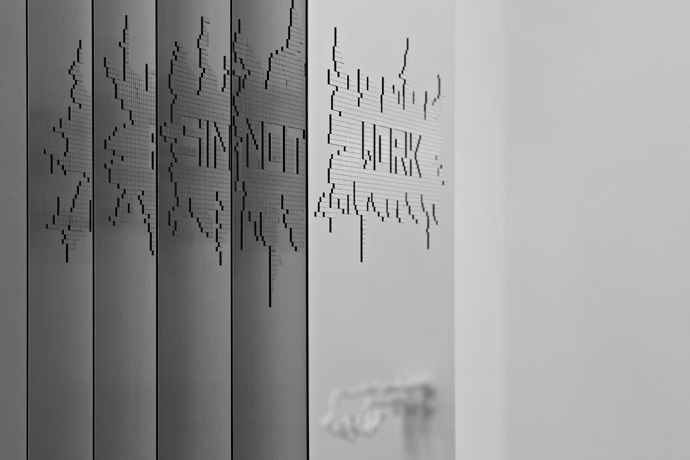 Marc Turlan: Statement Carpets. Courtesy gal Anne de Villepoix“It’s about the body. it’s erotic. Its a fetish to have in your mind to transform your body, to make a new image of yourself” he explains, next to two sculptures that look like snaffle headpieces with star shaped marble weights hanging from its leather thongs. It is inspired by gym gear to work your trapezius muscle. The materials surrounding us – leather, marble, mirror, wood. Marc Turlans recurrent structural elements are evident: eroticism, vanity, fetishism and notoriety.
Marc Turlan: Statement Carpets. Courtesy gal Anne de Villepoix“It’s about the body. it’s erotic. Its a fetish to have in your mind to transform your body, to make a new image of yourself” he explains, next to two sculptures that look like snaffle headpieces with star shaped marble weights hanging from its leather thongs. It is inspired by gym gear to work your trapezius muscle. The materials surrounding us – leather, marble, mirror, wood. Marc Turlans recurrent structural elements are evident: eroticism, vanity, fetishism and notoriety.Left: Marc Turlan's "Star Rack", and right: the artist himself
And there is of course, the star: “The star is the representation of the absolute, its a simple symbol for everyone. This desire, or fantasy to be recognised, to be famous, to arrive at this point… I use the star in marble.”In Marc Turlans “gym” you actually work out with the star as a marble weight, stemming the symbol of the desired recognition and thus transform yourself through and towards that idea.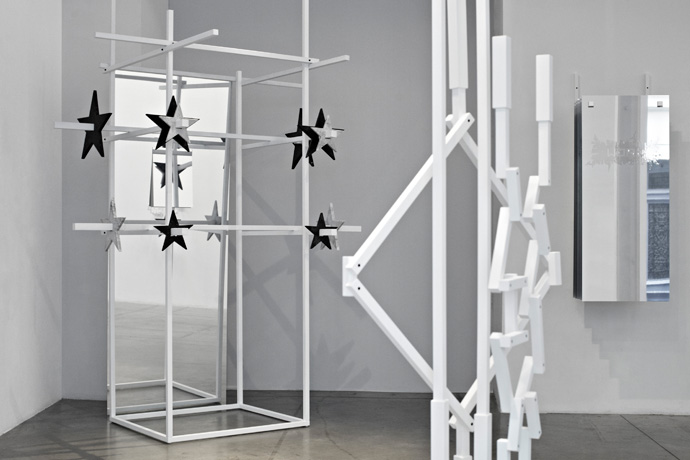 The first room of EXO STAR with "Home Star-Gym". Courtesy Gallery Anne de VillepoixThe second room is pitch black and only lit by pulsating light bulbs on a cluster of stars, an array of audio sculptures speak to the visitor with each a “collage sonore” (sound collage). Corresponding to the acoustic rework of a writers text hangs a framed object, containing a book of the same author with a mirror mosaic highlighting a sentence.“I keep a sentence very different to the audio collage. It is a proposition, an open invitation. I don’t work in an interactive way. I am interested in the object. It becomes a sculpture” he explains.
The first room of EXO STAR with "Home Star-Gym". Courtesy Gallery Anne de VillepoixThe second room is pitch black and only lit by pulsating light bulbs on a cluster of stars, an array of audio sculptures speak to the visitor with each a “collage sonore” (sound collage). Corresponding to the acoustic rework of a writers text hangs a framed object, containing a book of the same author with a mirror mosaic highlighting a sentence.“I keep a sentence very different to the audio collage. It is a proposition, an open invitation. I don’t work in an interactive way. I am interested in the object. It becomes a sculpture” he explains.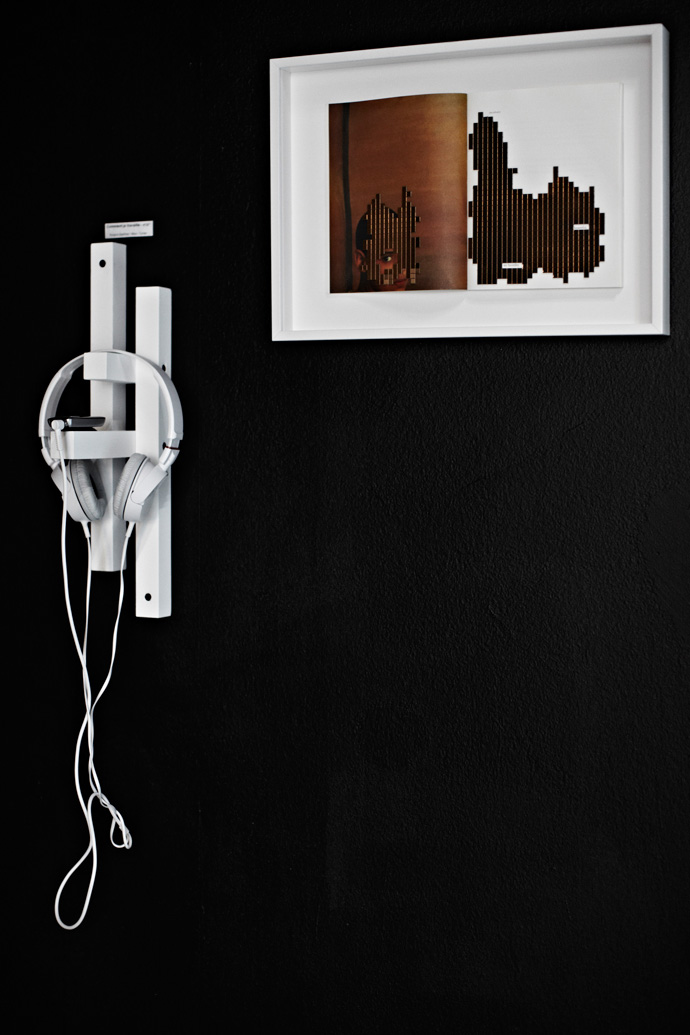
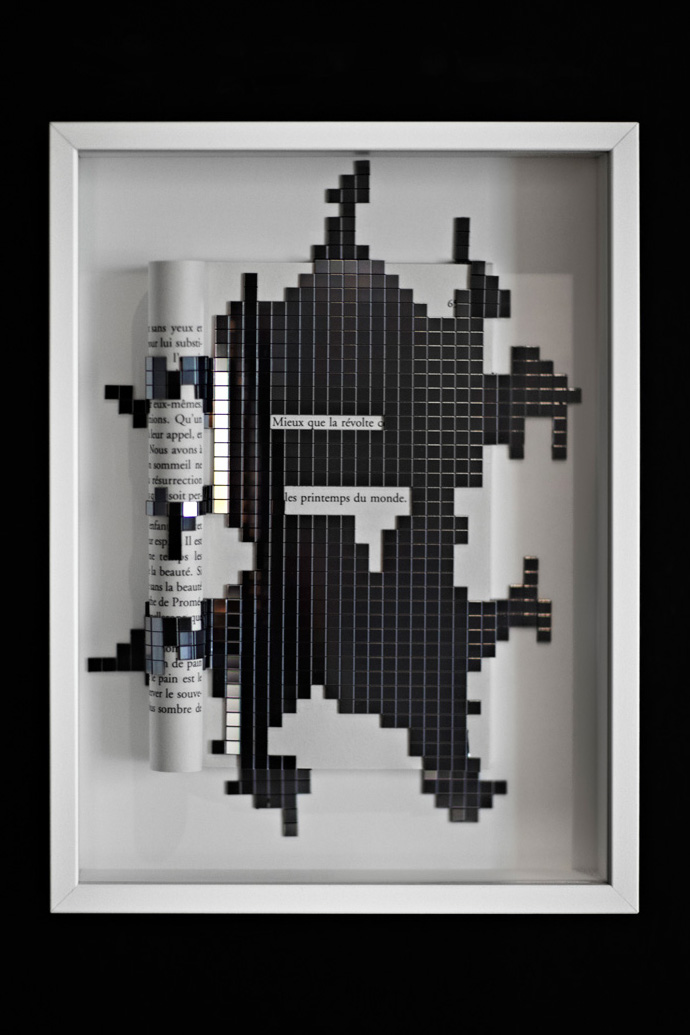 The collage sonore / sound collage installation in room 2. Courtesy Gallery Anne de VillepoixNear the pass to the next room the only book that depicts an image and with this marks the transition to the last complex of works. It’s all about stars and fashion magazines. But now the presentation enhances the fact that the magazines departed from being just the source of material. They become objects themselves, so does the frame and the fixture. It becomes altogether an installation: A cabinet of seven blocks present the works on shelves, hung, or in frames that at times can be turned and reveal a mirror. Mirrors everywhere. “Beyond, beyond, beyond the mirror”, as Patti Smith proclaims earlier in one of the audio collages.
The collage sonore / sound collage installation in room 2. Courtesy Gallery Anne de VillepoixNear the pass to the next room the only book that depicts an image and with this marks the transition to the last complex of works. It’s all about stars and fashion magazines. But now the presentation enhances the fact that the magazines departed from being just the source of material. They become objects themselves, so does the frame and the fixture. It becomes altogether an installation: A cabinet of seven blocks present the works on shelves, hung, or in frames that at times can be turned and reveal a mirror. Mirrors everywhere. “Beyond, beyond, beyond the mirror”, as Patti Smith proclaims earlier in one of the audio collages.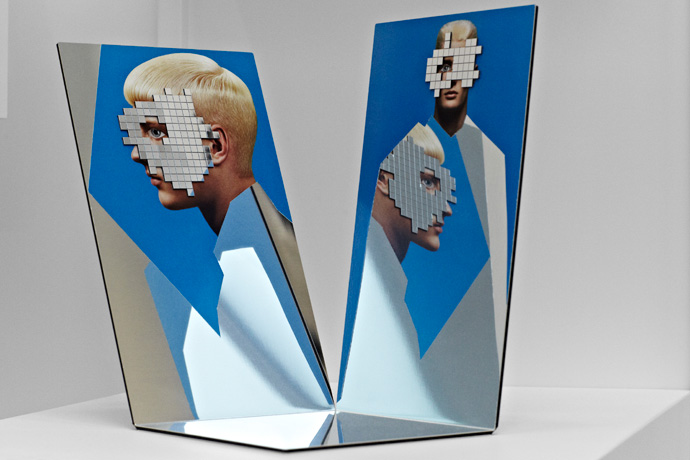 Object in room 3 at Gallery Anne de VillepoixMarc Turlan: EXO STARopening Saturday 10th, running to October 15th 2011at Galerie Anne de Villepoix, rue de Montmorency, 75003 Paris
Object in room 3 at Gallery Anne de VillepoixMarc Turlan: EXO STARopening Saturday 10th, running to October 15th 2011at Galerie Anne de Villepoix, rue de Montmorency, 75003 Paris -

not lost : ræve
-Once upon a time, we made a fashion film shoot with some of the best men’s designs around.
Givenchy, Raf Simons, Ann Demeulemeester, Rick Owens, Gareth Pugh, Comme des Garçons…we had it all. We also had a great concept (think butoh meets inception), a fantastic cast (Ippei is an amazing butoh performer, while Matvey and Willy, both top men’s models, would film Woodkid’s IRON video a few days later), great hair and great make-up, everything great.
RAEVE stroke-inducing poster by Clément Roncier.
Only problem was, we never really found the time to edit it.
Until now.
So without further ado, ræve.
RAEVE
by Antoine Asseraf & René Habermacherstarring Ippei Hosuka + Willy Cartier @ Success Paris + Matvey Lykov@ Success Paris
styling Jean-Luc Française / photo assistant Laurent Dubain / styling assistant Tiphaine Menon / hair Tanya Koch @ B Agency /make-up Akiko Sakamoto / studio Le Petit Oiseau Va Sortir
editing Axelle Zecevic / Clément Roncier / postproduction Clément Roncier / music Oedo Sukeroku “Shunrai” + John Cage “Sonata V” / special thanks Jean-Marc Locatelli
-

Efi Spyrou “swings”
-Cypriot Artist Efi Spyrou “swings” to our attention with the latest issue of Pop magazine SS 2011.
Efi Spyrou’s artistic reflection is interdisciplinary, her art on the conjunction of corporality and art theory. Often her approach, as manifested through her pieces and installations, seems cold and industrial. Yet it is charged with personal memories associating emotional moments. Remarkably enough, Efi operates with inhibiting elements of isolation, institutionalisation and discipline to achieve her purpose: ignite an emotional spark.
Efi Spyrou: Swing (1), 2010 marble, latex; 285 x 30 x 15cm. Photo by René Habermacher for PoP magazine SS 2011. Model: Ymre Stimkema.
This Issue of Pop magazine features a group of 5 contemporary artists: Gillian Wearing, Meredith Sparks, Linda Sterling, Clunie Reid and Efi Spyrou, Juxtaposing pieces of her SWING series with fashion by Antonio Marras, her work for this collaboration oscillates around the idea of “lost innocence”.
At this Chapter of her Life, Efi Spyrou contemplates inwards, both on personal and collective memory – after being in the spotlight as a fashion model, presenter and public figure that stood for the right cause:
She was involved in Campaigns of public interest as against eating disorders, “Fashion Targets Breast Cancer” and the UNHCR-the UN refugee Agencies ‘Against Women Trafficking’ and was subsequently awarded with the Cyprus “Leader of the Year in Advertisement”.
THE STIMULEYE finds Efi Spyrou in Athens, her hometown of choice for a conversation on her most recent projects,
including her first solo exhibition at Six D.O.G.S in Athens. The exhibition will run from May 6 2011.Efi Spyrou: Untitled, 2010, latex, iron, plexiglas, wood; 85 x 65 x 120
EFI SPYROU: Hi Rene! Here I am!
RENE HABERMACHER: hey hey- just saw you! welcome!!!!!
I think now it’s a good time for our conversation! Shall we?
In your work we find often references to childhood, as in your most recent SWING series, but as well for example in “Untitled” 2010 (incubator). What is the relation to yourself?
Each detail, each piece reflected on my work is connected to my memories, my experiences especially in my early ages. Sometimes I feel I was literally thrown from childhood to adulthood in an instant moment… There is an inner need to go back again and start from scratch, with a different pace.
How did you grow up?
In a very disciplined way…
I grew up in a very small, conservative, strict, disciplined community where freedom of speech was not something really known… After my 18th birthday, when I decided to leave my homeland Cyprus, I was catapulted into the wild world of which I knew nothing about! And first of all, I knew nothing about rapacity…I was 18 years but I had the feeling to be in fact much, much younger and very scared.
Following your journey had taken you quite somewhere else- in terms of location and orientation. You returned only much later to your point of departure, with your art and the themes your current work embraces.
After 17 years I am in the position to say that this journey was difficult but full of colours, aromas and sounds, the voices of different cultures, people, moments. You see, I have entered the fashion world as a model and subsequently public figure, which gave me the chance to travel a lot all over the world. Although I had great moments, and I do feel lucky about it – I had to test my limits, my values and myself in many ways: In this race the cost was not insignificant. That is why there was a turning point, of explosion, – I had to slow down – and turn the time back, back to my roots and see which were the remains! This is where art gave me the tools to deal with all this material I had in my hands…
Efi Spyrou: Swing (2), 2010, silicone, latex; 75 x 30 x 15cm. Photo by René Habermacher for PoP magazine SS 2011. Model: Ymre Stimkema.
When we met last time in London to do our project for POP, we were focusing on your most recent work, the SWING. In fact it was a juxtaposition of your art with the fashion by Antonio Marras, under the helm of Isabelle Kountoure. It seemed like another circle had closed: with this new pieces that reflect on lost innocence and the interweaving with fashion that had marked another phase of your life.
This was a liberating experience for me. Every time I find the medium to make a conclusion of my contradicting “memory voices”… is an exciting moment. With the series of my works SWING, I had the chance to cooperate with a great team, working on the upside of fashion. And in parallel I had the chance to give light to a darker “space” as you say, “our lost innocence”. This is the only way for me to survive- to accept my bipolarity…
You started with the first piece of your “swing”series in marble. For this project you took cooperations with other people in account – thus creating more facets around the actual object…
The first piece was more an inner conversation. The development of the piece[s] through this cooperation was a conversation with others! This is really important for me, because I do believe that our personal “spaces” from a different perspective are collective “spaces”. The former is the reflection of the latter and vice versa!
In art, the material plays a significant role in the interpretation of the piece.
During our collaborative working process i’ve developed other variants of the original swing: wax, silicone, plaster and mirror. Doing so, I leave an open interpretation of my recent Swings”. What matters to me, is not to give a solution to a problem, but to actually “spark off” something…Swing (3), 2010 by Efi Spyrou: paraffin wax, latex; 335 x 30 x 15cm. Photo by René Habermacher for PoP magazine SS 2011.
As you operate not only plenty with personal memories, but integrate the collective as well – in this context, how important is Athens, or Greece as a background for your work?
For my own work I incorporate a universal, collective memory in my pieces – at least this is what I am trying to do. Sometimes it could be characterised more “western”… but not surely Greek or Cypriot. I can assure you though that my life in Athens and especially the “new” way I look at the city and its everyday life here, gives birth to a lot of new ideas + questions + art pieces!
Spring, especially these days, is so refreshing! I cannot think of economic crisis – I keep my worries silent for the moment.
As far as concerning the emerging art scene over here: I think there is a lot to be done, in order to consider Athens as part of the greater art map. But I see a young art generation which is very promising…What are you working on right now and next?
I am preparing a solo exhibition in May. The show will be running from May 6th at the Six D.O.G.S exhibition space in Athens. Included on display are among new works some ready pieces that are already known.
For the moment I am studying the relationship of memory with the game of lights and shades in space. I am working on sketches right now, may be for an installation, we will see…
I would love to have the chance for more collective dialogues in the future.Efi Spyrou: Swing (2), 2010, silicone, latex; 75 x 30 x 15cm. Photo by René Habermacher for PoP magazine SS 2011.
Thank you so much for this insightful talk!
Shall I say sweet dreams?
Efi Spirou’s solo exhibition at Six D.O.G.S, 6-8 Avramiotou Street, 10551, Athens, Greece
The exhibition will run from May 6 2011.a collaboration EFI SPYROU | ANTONIO MARRAS pop Magazine SS 2011
Hair Panos Papandrianos at CLM using Bumble and bumble
Make-up Yannis Siskos at Effex using Giorgio Armani Cosmetics
Model Ymre Stiekema at Viva London
Casting Angus Munro at AM Casting, Streeters NY
Set Design Emily Pugh
Photography Assistance & Digital Technician Laurent Dubin
Fashion Assistance Tui Lin
Hair Assistance Angel Sayers
Digital Remastering Dimitri Rigas at Dimitri.jp
Shot at The Russian Club Studios
